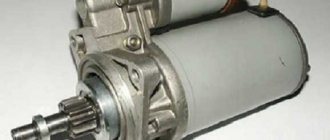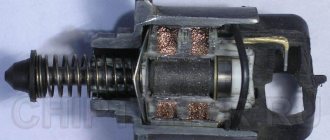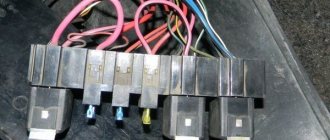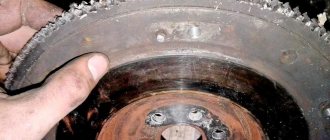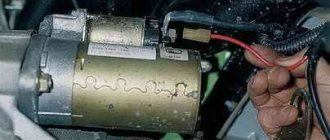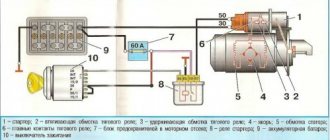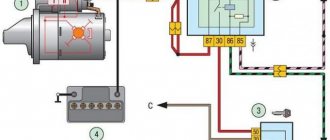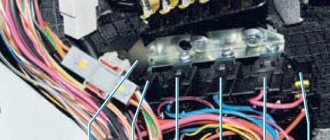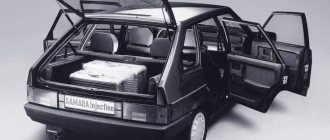The car has long become an integral part of our lives. It is quite difficult for many of us to imagine life without him. But sometimes there comes a time when the car stops starting at the most inopportune time.
Faced with such a problem, many car owners have no idea what to do in such a situation. We will try to help solve the problem when the Priora does not start and the starter does not turn the engine and what actions should be taken first.
How does a starter work?
This device is an electric motor with a gear that meshes with the engine flywheel and rotates it when started. A retractor relay is installed on the housing, which controls the movement of the gear and the automatic activation of the electric motor.
When the ignition key is turned to the start position, power is supplied to the relay and, through an electromagnet, it is drawn in, moving the gear using a special mechanism and simultaneously closing the contacts, starting the electric motor.
The moment the ignition key is released, power stops flowing to the relay magnet; it operates in the opposite direction, opening the contacts. Thus stopping the operation of the electric starter. Here is an approximate elementary diagram of the operation of the engine starting system.
Mechanical and electrical problems
The engine starter may not work due to wear out of the bearings located at the front and rear of the engine. Their function is to ensure smooth acceleration of the starter shaft. If they are worn out, the retractor will make clicks, and the crankshaft of the power unit will remain motionless. The reasons for this problem are:
- imbalance of the starter shaft;
- burning or short circuit of winding turns.
Note that this may cause a short circuit in the vehicle's electrical circuit, which may cause a fire. If the starter does not respond to turning the ignition key, you cannot force it to work for a long time. It is best to make several short starts of the engine.
Since the design of the vehicle’s power unit starting device is based on an electric motor, the voltage necessary to increase the speed of its shaft is supplied to the winding through graphite brushes. The material they are made of does not have sufficient strength, these elements wear out quickly.
Where to start if the starter does not turn and the Priora does not start after several attempts
If the relay makes a clicking sound when you turn the key:
If the battery is ok:
- after several attempts to start the car, touch the wires coming from the battery; when they heat up, you need to check the contact between them and the battery;
- remove the terminals from the battery and clean them;
- reinstall the terminals;
- check the connection of the ground terminal to the body, if necessary, clean the connection;
- check the connection of the positive terminal with the contact on the starter;
- it is necessary to check whether power is supplied to the relay from the ignition switch; to do this, disconnect the connector from the solenoid relay;
- turning the ignition key to the “start” position, use a tester to measure the voltage at the connector;
If all of the above does not have an effect, you need to remove the starter from the car and check it.
Where are the fuses on the Priora?
- The main mounting block of the Priora is closed with a lid and located at the driver’s left foot. To open it, you need to turn three latches 90° and unclip the lid.
- The fuse box is under the hood, which is located near the expansion tank.
- Another mounting block, which is located near the left foot of the front passenger. To gain access to the fuses and relays, unscrew several screws with a Phillips screwdriver.
This is interesting: The consequences of pressing the start/stop button while the car is moving
Below is a description of each fuse and relay block in order.
Removing the starter
- disconnect the terminals from the battery;
- unscrew the air filter and remove it;
- Unscrew and remove the positive wire from the starter terminal;
- disconnect the connector from the relay;
- unscrew the starter mounting nuts and remove it;
Checking the relay operation
Using emergency wires for “lighting up”, connect the negative wire from the battery to the electric starter housing. Connect the positive one to the relay connector, and it should operate and throw the gear forward. If the result is negative, the relay must be changed.
Checking the operation of the electric motor
By hooking the negative wire to the electric starter housing, and the positive wire to the lower terminal of the retractor relay. The electric motor should start working. If this does not happen, then most likely the motor brushes need to be replaced.
Having examined the reasons why the starter does not turn and the Priora car does not start, we can conclude that the electric starter itself may not always be the cause of the problem. Most often these are bad contacts in the system connections or simply a broken wire.
But if the reason is still in the starter, do not rush to buy a new one. Many faulty parts can be replaced by simple overhaul, saving money. And the old starter will last for a long time.
Source
Answers to frequently asked questions
How can you tell if the starter relay is not working?
To determine whether the starter relay is working, apply power from the positive terminal of the battery directly to the control contact of the relay. After this, a click should sound; if it is faulty, there will be no sounds.
How to check whether the starter is working or not?
To check the serviceability of the starter itself, you need to apply current to it directly by connecting the power wires of the retractor relay (thick wire from the battery) and the electric motor (stud with a thick wire from the retractor to the starter). A working starter should start moving.
What to do if the starter does not work after turning the ignition key?
First, make sure there is voltage at the battery terminals. If you don’t have a tester, this can be done using a 12 V lamp. Then try to apply voltage directly to the starter: use a screwdriver to close the pin to which the wire from the battery goes and the control contact located nearby. If there is no reaction, check the quality of the contacts of the terminals on the battery, the ground contacts (with the body and the engine) and the contacts of the starter itself by cleaning and tightening the terminals. If the battery is discharged or the starter is faulty, you need to start the car with a pusher (manual transmission) or tow it to the repair site.
Why does the starter not work with the ignition key?
The main reasons why the car does not respond to the ignition key:
- control relay failure;
- breakdown of the ignition switch/contact group;
- wire break or short circuit;
- problems with the anti-theft system (alarm, immobilizer);
- breakage of the solenoid relay;
- starter motor failure.
If the starter turns directly, but not from the key, then the last two problems can be eliminated.
Source
What to do if the Lada Priora does not start and does not turn the starter
A car is often included in the list of the most necessary items for a comfortable life, and the inability to use it is perceived by many as a serious deprivation. However, all equipment breaks down sooner or later, and a car, for example, may stop starting. Here, the first thing that is required is to find the cause and fix the problem as quickly as possible. The trouble is that owners often have no idea where to start the work. In this article we will tell you why the Priora specifically does not start and why its starter does not turn.
Ignition
Ignition problems, as experts say, occur quite often in Priora. It is relatively easy to verify the functionality of this system. This is done by checking for the presence of a spark on the spark plugs. If it is not there, then it is possible that:
- the ignition unit is broken;
- The crankshaft and distributor sensors do not work correctly.
To conduct a full diagnosis, you will need to visit a car repair shop. Here, special equipment is used, through which it is easy to determine which element is causing the problem.
If there is no spark at the spark plugs, we can say with a high degree of confidence that they have failed:
- ignition unit;
- his reel.
general information
The starter is the key mechanism that ensures the starting of any vehicle equipped with an internal combustion engine. In fact, it is an electric motor equipped with a special gear with a transmission mechanism. When activated, the part engages with the flywheel and rotates it, thereby providing a start to the gasoline engine.
The control element is a solenoid relay. It supplies voltage to the unit’s motor and regulates the stroke of the bendix. When the driver turns the key in the ignition, an electrical circuit is activated. Current flows to the relay magnet, which attracts the armature, which closes the contact group, which causes the starter to spin.
The force it creates is transferred to the flywheel, the crankshaft begins to rotate and the car engine starts. After this, the driver releases the key, the power is turned off, and the relay opens the contacts, after which the starter stops working.
Bendix and retractor
The above symptoms will indicate that the fault is localized to the solenoid relay or the bendix does not engage the flywheel. Note that in the case of Bendix, a more characteristic sign is that the starter crunches and does not turn the engine. Another common sign of a bad starter is that the starter buzzes but does not turn the engine.
To check the traction relay, voltage must be supplied from the battery to the power terminal of the relay. If the engine starts to turn over, then the retractor starter is obviously faulty. A frequent breakdown is the burning of the contacts. To eliminate it, you will need to remove the relay to clean the nickels.
After cleaning, you must still be prepared to quickly replace the traction relay, since in the factory the contact pads are covered with special protection that resists burning during operation. Stripping will mean that the specified layer is removed, as a result of which it is difficult to predict the moment when the retractor coins will burn again.
Now let's turn our attention to the starter bendix. Bendix is a gear through which torque from the starter motor is transmitted to the flywheel. The Bendix is mounted on a single shaft with the starter rotor. To better understand, it is necessary to understand how a starter works. The principle of operation is that after turning the ignition key to the “start” position, current is supplied to the solenoid relay.
After the engine starts (the crankshaft begins to rotate on its own) with a working starter, the key in the ignition switch is thrown back, and electric current no longer flows to the traction relay. The lack of voltage causes the retractor to disengage the bendix from the flywheel, as a result of which the starter stops spinning.
New Lada: Bosch, Brisk, Denso, NG, DVRM spark plugs for Lada Priora - which ones to choose and how to replace
Wear of the Bendix gear means that there is no normal connection with the flywheel ring. For this reason, a cracking sound may be heard when starting the engine, and the starter may spin freely without engaging and buzzing. A similar situation arises if the teeth of the flywheel rim are heavily worn.
The repair involves disassembling the starter to replace the bendix and/or removing the transmission to replace the flywheel. To check the bendix yourself, you will need to close two power contacts on the traction relay. The electric current will bypass the relay, which will determine the rotation of the starter. If the starter rotates easily and hums, you should check the quality of engagement of the bendix with the flywheel.
If Priora does not want to start
When the car does not start and its starter, accordingly, does not turn, then most likely the culprit is the battery. This is indicated by the following additional symptoms:
- the solenoid relay clicks;
- The instrument lights on the panel go out.
The easiest way to test the battery is to turn on the headlights. If they burn weakly, you will have to charge the battery.
When the battery appears to be in good condition, but the car still does not start, feel the cables connected to it. If the ends screwed to the terminals (or the starter itself) are warm, then there is poor contact or oxidation. All this creates increased resistance, stealing battery power.
- unscrew the wires;
- clean the battery leads and terminals themselves;
- return the cables to their place;
- Make sure that the ground on the body and the positive on the starter are securely fastened.
Next, check if there is voltage at the ignition switch. This is done like this:
- disconnect the connector of the cable going from it to the traction relay;
- turn the key to the engine start position;
- measure the voltage at the connector.
When nothing suspicious is found here, go to the Priora traction relay. Power it directly from the battery. It is convenient to use cigarette lighter wires for this.
Connect the minus to the starter housing, and the plus to the corresponding relay terminal. Ideally, the mechanism should start working, that is, its shaft will begin to rotate and the gear will move forward.
If this does not happen, try changing the control element itself and if the result is negative, take on the starter electric motor:
- Leave the negative wire from the battery on the body;
- plus, hook it to the lower contact of the solenoid relay.
A working engine will start working. If not, then look at its brushes. They can wear out and need to be replaced regularly.
The lack of a positive result allows us to draw one conclusion - the main reason why the Priora does not want to start is a bad starter. The unit is not repaired, but replaced with a new one.
Frequent malfunctions on popular cars
In most cases, the starter does not turn when the ignition key is turned due to oxidation and mechanical damage to the wiring. If there is poor contact with the “+” terminal of the battery, the control relay or ground, the starter does not receive enough current to crank the engine . Therefore, first of all, you need to look at the contacts in the engine compartment and check for voltage at the terminals with a tester. The most common malfunctions of specific car models, due to which the starter does not respond to the ignition key in the table.
| Why does the starter not work from the ignition key on popular car models? | |
| Auto | Weakness |
| VAZ 2110, 2111, 2112 | Wires of the central locking and ignition switch, which melt due to power surges. |
| VAZ 2108, 2109, 21099, 2113, 2114, 2115 (Lada Samara) | Oxidizing contacts of the control relay located in the engine compartment above the VUT, as well as the wiring extending from it. |
| VAZ 2101, 2102, 2103, 2104, 2105, 2106, 2107 (Classic) | The contact “nickels” of the solenoid relay often burn or oxidize. The contact group of the ignition switch fails. On later models, for example, 2107, problems with the control relay are similar to Samara (see above). |
| Niva | On old Nivas (before 21213), the ignition switch contacts burn and oxidize. On newer ones (after 21214), the starter control relay, located under the hood near the brake fluid reservoir, often fails. There is a drainage tube located nearby that drains water from under the glass, moisture from which gets onto the relay, which leads to oxidation of its contacts. |
| Lada Priora | Immobilizer problems due to which it does not see the key. |
| Lada Kalina, Lada Granta | Failure of the immobilizer, blocking the start, malfunctions in the contact group of the ignition switch and failure of the additional starter relay K3 in the fuse block. |
| UAZ | Malfunction of the 5-pin starter control relay and solenoid relay. |
| Gazelle | Poor contact of wires and failure of the starter relay. |
| Peugeot 307 | Solenoid relay fuse F8 blows, poor ground contact. |
| Kia Sid | The limit switch of the automatic transmission selector, which determines the P and N positions, is faulty. There may be poor contact at the starter terminals or at the point where the ground wire is attached to the body. |
Lada won't start when cold
Check how fast the crankshaft spins on your Priora. Too low a speed indicates:
- dead battery;
- hardening of the lubricant.
The absence of any reaction from the motor suggests that the problem lies in:
- fuel system - sometimes condensate freezes there;
- a sensor that monitors the temperature of the antifreeze;
- loss of tightness of nozzles;
- weak compression in the cylinders;
- failure in the on-board computer.
If the car starts unstably in winter, then perhaps there is low-quality gasoline in the Priora tank or a lot of condensate has accumulated. It would also be a good idea to look at the spark plugs and the cables leading to them from the distributor, the ignition unit itself, and the sensor that monitors the oxygen level.
Common starter problems and their causes
Before removing and replacing the device with a new one, let's look at the most common unit malfunctions:
- The starter unit does not turn on. The cause of the problem, most likely, is a broken contact or a short circuit in the electrical circuit of the device. Also, the mechanism may not turn on due to a breakdown of the traction relay.
- When trying to start the engine, clicking noises are heard. If the battery is charged, the reason may be loose contacts in the electrical circuit or a breakdown of the holding winding of the traction relay.
- The mechanism turns on but does not rotate or rotates very slowly. If the battery is not discharged, then the reason should be sought, again, in broken contacts or their burning on the relay. Also, rotation may be difficult as a result of contamination of the commutator or wear of the brush assembly; it is quite possible that the reason lies in a short circuit in the windings. Moreover, the circuit can be either short or interturn.
- The mechanism turns on and its armature rotates, but the flywheel is motionless. Most likely, the problem lies in the loosening of the assembly clamp to the clutch housing or physical damage to the teeth of the flywheel or gear. Also, the reason may be slipping of the clutch, failure of the lever, or breakage of the buffer spring and drive ring.
- After successfully starting the engine, the starter mechanism does not turn off. The problem in this case may be a failure of the freewheel or burning of the relay contacts. If this is the case, then the engine must be turned off as quickly as possible to prevent complete failure of the unit (video author - Lexin channel).
What to do if the Lada Priora does not start and the starter does not turn
Now many Russians cannot imagine life without a car.
Therefore, it is easy to understand them when the vehicle suddenly stops starting at one, far from perfect moment. This is even more unpleasant if it happens in the morning before leaving for work. At the same time, many car enthusiasts are lost in such a situation and have absolutely no idea how to fix the breakdown on their own.
This material will tell you why a car like Priora may not start in cold weather, and why its starter does not turn. It is important to note that in most cases the problem can be easily fixed on the spot, and if you know how to do this, you can save a lot of money on a car service.
How to solve the problem and start the engine?
How to start a car if the starter is faulty?
There are several options to solve the problem:
- The most common is to start the engine using a pushrod. The car must be pushed until it can reach a certain speed required to take off, preferably in third or second gear. Only a car with an automatic transmission cannot be started from a pusher.
- Try closing the starter. To do this you will need a screwdriver as well as a wrench. The size of the key must be selected in accordance with the distance between the relay terminals - they will need to be closed. The gearbox selector is set to neutral, the brake pedal is pressed, and the key must be in the required position.
- As a rule, the starter simply has to be repaired, but as practice shows, this mechanism can rarely be repaired. It would be advisable to make repairs if the bendix or relay fails. If the malfunction affects the electrical system, the device will need to be replaced.
Reasons for failure of the starting system
Most often the following happens:
- For some reason the electric starter does not turn on - the reason is a broken wiring, short circuit or breakdown of the traction relay;
- the starter starts, but an uncharacteristic clicking sound is heard - damage to the coil of the above relay or discharge of the battery;
- the start works, but the starter does not turn or rotates too slowly - the battery is dead.
In addition, the reason here may lie in:
- loss of contact;
- brush wear;
- collector contamination;
- short circuit of the winding wires.
It also happens that the starter works normally, but the flywheel still does not rotate.
Here, first of all, you need to make sure that the attachment to the crater installed on the clutch is not broken. Then you will have to check the integrity of the teeth of the flywheel itself or the drive gear.
It happens that the 16-valve Priora does not turn off the starter after the power plant is factory installed. This happens due to a malfunction of the clutch that ensures the free movement of the unit in question. Sticking of the relay contact group also leads to the same result. If this malfunction occurs, you must immediately turn off the engine.
Problems with the Priora plant often arise due to ignition failure. In this case, you need to make sure that:
- the coils are securely fastened to the power plant;
- there was no break in the ignition wires in its low-voltage circuit;
- whether the spark plugs are working (if there is no spark, you will need to replace the ignition coil).
Problems with the relay or battery
If, when you try to start a Priora car or a car of another brand, you hear a click, but the starter turns very slowly, you need to clean the nickels.
In some situations it may be necessary to solder a new contact layer. If you suspect that the cause is in the motor, you need to close the contacts in the relay. If after this the engine was able to start the first time, look for the cause of the malfunction in the relay. Otherwise, the cause lies in the engine itself. Often this problem occurs due to a fault in the relay. This is evidenced by the occurrence of several clicks that occur one after another when trying to start the car. If you listen, it becomes clear that this sound is made by a relay. It occurs due to the fact that the starter receives an electrical charge, but the current only reaches the traction relay and does not reach the engine spin-up mechanism. In this case, you can immediately rule out the version of a discharged battery, since due to the low charge, the starter would still be able to turn, but slowly and only a few times.
Source
Starter operating principle
This device itself is a conventional electric motor. A gear is installed on it, which meshes with the flywheel, which rotates when the power unit starts. A traction relay is also attached to the housing. The functions of this element include:
- gear movement control;
- starter disconnection.
When the key is turned to the starting position, voltage is supplied to the relay, exciting the electromagnet windings, then the contacts close. At the same time, the gear begins to rotate and the motor starts.
When the key is released, the voltage to the relay windings stops supplying and the contacts separate. The starter is accordingly turned off. This is, in general, the entire description of the operation of the node in question.
Information about the design of the starter and its supply wiring
An automobile starter is attached to the engine block and is designed to impart rotation to the crankshaft through a ring gear on the circumference of the flywheel. The main components of the starter:
- An electric motor consisting of a rotor, a stator and a brush unit that powers the rotor windings.
- Freewheel with drive gear (Bendix). This also includes the simplest mechanism that moves the coupling along the shaft.
- Solenoid relay. A powerful solenoid that controls the supply of the clutch and also closes the power contacts of the electric motor.
Two electrical circuits are connected to the starter, a power supply and a control or signal circuit. The first supplies all the energy consumed during operation, and the second serves to turn the device on and off.
Starter operation in normal mode
When the driver gives a command to start the engine, the ignition switch contacts that switch the starter are closed, and voltage is supplied to the control relay. It is used to unload the contact group of the lock from high currents of the pull-in winding. Sometimes this relay is missing, then the ignition switch is made more massive, capable of switching without being burned by significant currents.
After the relay or ignition switch, if it is absent, the signal comes to the control contact of the solenoid relay. Both of its windings are triggered, after which the retractor is excluded from the circuit, and the retainer continues to supply power through the power contacts to the electric motor. At the same time, due to the movement of the solenoid armature, the freewheel engages with the flywheel, imparting rotation to it from the starter. When the engine starts, it throws the clutch back, thereby preventing the starter from “racing” at high uncontrolled speeds. The driver turns off the starter, removing the voltage from the holding winding, the spring returns the solenoid armature to the forward non-working position. Sometimes this is done automatically by control electronics.
Why may the starter not turn?
If the start occurs in a cold or frosty environment, then several attempts should be made before starting to troubleshoot. In case of a complete fiasco, when when you turn on the relay clicks and the indication on the panel goes out, you need to do the following:
- make sure the battery is charged;
- check whether all the wires coming from the battery are cold - the presence of heating indicates poor contact (the terminals need to be cleaned);
- see whether the battery connectors are securely connected to the ground, and whether it is securely connected to the body of the car (existent contaminants are eliminated);
- make sure that the plus on the starter contact is holding well.
The traction relay is disconnected from the wiring if there is doubt about the normal operation of the ignition switch. Then the key is set to start, and a multimeter is used to check the presence of voltage directly at the removed connector.
When none of the above helps, you will need to dismantle the starter itself.
Individual situations
If the VAZ 21099 injector stops starting, you can try to close the contacts of the mechanism in a straight line.
We recommend: Oil leakage from under the crankshaft oil seal: causes and troubleshooting
But sometimes there are emergency situations when the device stops functioning, let’s consider a few of them:
- The injection engine does not start in cold weather, but all devices work normally, the battery is charged. If there is no click, you should first diagnose the safety components, electrical circuit, and also the solenoid relay. If the device clicks, the relay must be replaced.
- The starter turns all day, there is a spark, but in the evening the engine stops starting. Before checking the starter, it is necessary to fully charge the battery, and then clean the contacts on both the battery and the mechanism itself. If these steps did not help solve the problem, you need to check the battery itself more carefully - try closing the contacts with a wire, which may cause a spark to melt. If this does not help, try applying a positive charge from the battery directly to the relay. If there are no changes, the unit will have to be replaced.
- If the car was operated normally all day, but after parking for five minutes it stopped starting, you can try to close the mechanism. You need to directly close two bolts on the relay; if this helps, but later the problem reappears, then disassemble the unit completely. Most likely, the problem lies directly in the erasing of the brushes. In this case, they will need to be changed.
- The unit does not turn at all, but the car can be started from the pushrod. If the problem is not with the starter, then check the fuse box and ignition switch. But before this, you should check the wiring - the reason may lie in the oxidation of the contacts.
How to remove the electric starter
The procedure in this case is as follows:
- remove the terminals from the battery;
- the “plus” connector is removed from the starter;
- removed from the relay block;
- The nuts securing the faulty unit are unscrewed.
Then you can safely remove it.
Next you will need to check the functionality of the relay. To do this, take emergency wires to start from another car. The negative one is installed on the battery and on the starter housing. “Plus” is connected to the relay. The latter in this case (if it works properly) is triggered and moves the gear. The absence of this reaction indicates a breakdown of this element.
When there is no reason to suspect the relay, you need to try to start the starter itself. The “minus” remains in place, and the “plus” is set to the lower output of the relay. The motor should start working. A negative result indicates wear of the graphite brushes.
Fuel system
Problems here also very often prevent the car from starting when cold. First of all, you need to check whether there is the necessary pressure directly in the fuel rail. The pressure gauge is connected to the fitting installed on it. When, after turning on the ignition, it does not increase, then most likely the following has failed:
- gasoline pump;
- relay controlling it;
- fuses have blown.
You can simply verify that the unit is working – just listen in the cabin. If the pump starts, a characteristic sound will be heard from the rear seats.
After this, you will have to find out whether the suction pipe in the fuel tank is clogged and whether fuel passes through all the hoses.
Often, poor starting is due to the quality of the gasoline being poured being too low. It may, in particular, contain water or other foreign impurities.
It is important to pay special attention to the following point - if the injectors are working, clicks will be heard. If they are absent, you need to check the voltage in the on-board network and the presence of ground. It should also not be ruled out that the problem lies in the ECU or power relay.
It is worth checking whether the candles are wet. This happens quite often after the power plant has overheated. In this case, they are removed from the nests and examined. Quite often, simply wiping them dry is sufficient.
In the end, I would like to say one thing - in order for the car to continue to work without failures in the future, you only need to regularly care for it, carry out preventive maintenance and promptly prepare it for the winter period.
